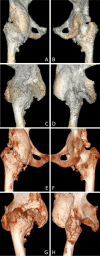Comparison of magnetic resonance imaging and computed tomography for bone assessment of neurogenic heterotopic ossification of the hip: a preliminary study
- PMID: 34930354
- PMCID: PMC8686225
- DOI: 10.1186/s13018-021-02869-6
Comparison of magnetic resonance imaging and computed tomography for bone assessment of neurogenic heterotopic ossification of the hip: a preliminary study
Abstract
Background: Neurogenic heterotopic ossification (NHO) is a frequent complication, often involving the hip. The functional impact may require surgical management and pre-surgical imaging assessment is necessary, usually by computed tomography (CT). We aimed to compare the performances of magnetic resonance imaging (MRI) and CT for bone assessment on pre-surgical imaging of the heterotopic ossifications and their features in NHO of the hip.
Methods: This single-center prospective preliminary study included all patients who underwent surgery for NHO with joint limitation from July 2019 to March 2020. All patients had a CT after biphasic iodinated solution injection and an MRI including T1-weighted, STIR and ZTE sequences. Standardized reports were completed for both exams for each patient, evaluating location, implantation and fragmentation of NHO, relation to the joint capsule and bone mineralization, then were compared.
Results: Seven patients from 32 to 70 years old (mean = 50.2 ± 17.2 years) were evaluated. NHO were bilateral in 2 patients, for a total of nine hips: six right hips and three left hips. Observed concordance rates between MRI and CT were, respectively, 94.4% for location, 100% for circumferential extension, 87.3% for implantation 88.9% for fragmentation, 77.8% for relation to the joint capsule and 66.7% for bone mineralization. It was 100% for femoral neck fracture and osteonecrosis of the femoral head.
Conclusion: This preliminary study suggests that pre-surgical MRI imaging should be considered as effective as CT for bone assessment of NHO and their features.
Trial registration: ClinicalTrials.gov, NCT03832556. Registered February 6, 2019, https://clinicaltrials.gov/ct2/show/NCT03832556 .
Keywords: Magnetic resonance imaging; Neurogenic heterotopic ossification; Zero Echo Time.
© 2021. The Author(s).
Conflict of interest statement
The authors declare that they have no competing interests.
Figures






References
-
- Law-ye B, Hangard C, Felter A, Safa D, Denormandie P, Genet F, et al. Pre-surgical CT-assessment of neurogenic myositis ossificans of the hip and risk factors of recurrence: a series of 101 consecutive patients. BMC Musculoskelet Disord. 2016;17(1):433. doi: 10.1186/s12891-016-1294-2. - DOI - PMC - PubMed

